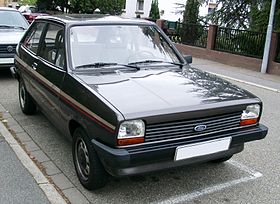Ford Fiesta (first generation)
| Ford Fiesta Mk1 | |
|---|---|
 |
|
| Overview | |
| Manufacturer | Ford Europe |
| Production | 1976–1983 |
| Assembly |
Almussafes, Spain (Ford Valencia) Dagenham, United Kingdom (Ford Dagenham) Cologne, Germany (CB&A) Saarlouis, Germany (SB&A) |
| Body and chassis | |
| Class | Supermini (B) |
| Body style | 3-door hatchback 3-door panel van |
| Powertrain | |
| Engine | 957 cc (58.4 cu in) Valencia I4 1,117 cc (68.2 cu in) Valencia I4 1,298 cc (79.2 cu in) Crossflow I4 1,597 cc (97.5 cu in) Crossflow I4 |
| Transmission | 4-speed BC4 manual |
| Dimensions | |
| Wheelbase | 2,286 mm (90.0 in) |
| Length | 3,565 mm (140.4 in) |
| Width | 1,567 mm (61.7 in) |
| Height | 1,360 mm (54 in) |
| Chronology | |
| Successor | Ford Fiesta (second generation) |
The Ford Fiesta Mk1 was the first generation of the Ford Fiesta supermini. Originally introduced in 1976, it was Ford Europe's first multi-national front-wheel-drive automobile, and was available in both 3-door hatchback and panel van body styles. In 1983, the Fiesta was updated, and the Fiesta Mk2 was introduced.
The Fiesta was originally developed under the project name "Bobcat" (not to be confused with the subsequent rebadged Mercury variant of the Ford Pinto) and approved for development by Henry Ford II in September 1972. Development targets indicated a production cost US$100 less than the current Escort. The car was to have a wheelbase longer than that of the Fiat 127 (although shorter than some other rivals, like the Peugeot 104, Renault 5 and Volkswagen Polo), but with an overall length shorter than that of the Escort. The final proposal was developed by Tom Tjaarda at Ghia. The project was approved for production in December 1973, with Ford's engineering centres in Cologne and Dunton (Essex) collaborating.
Ford estimated that 500,000 Fiestas a year would be produced, and built an all-new factory near Valencia, Spain; a trans-axle factory near Bordeaux, France; factory extensions for the assembly plants in Dagenham, UK. Final assembly also took place in Valencia.
...
Wikipedia
